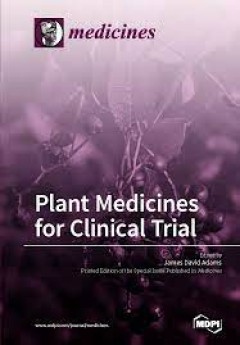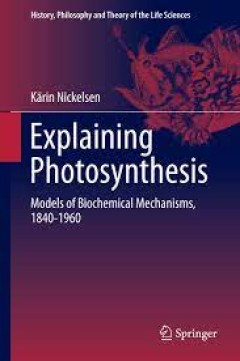Filter by

Advances in Plant Breeding Strategies: Agronomic, Abiotic and Biotic Stress T…
The basic concept of this book is to examine the use of innovative methods augmenting traditional plant breeding towards the development of new crop varieties under different environmental conditions to achieve sustainable food production. This book consists of two volumes: Volume 1 subtitled Breeding, Biotechnology and Molecular Tools and Volume 2 subtitled Agronomic, Abiotic and Biotic Stress…
- Edition
- Ed. 1
- ISBN/ISSN
- 978-3-319-22518-0
- Collation
- XII, 707
- Series Title
- -
- Call Number
- 630 ADV a

Plant Medicines for Clinical Trial
Our species has always used plants as medicines, during our 200,000 year existence. This is made obvious by the plant medicines found in mummy burials, around the world, dating back thousands of years. Human beings evolved using plant medicines to stay alive. This has resulted in a genetic selection in which those who were healed by plant medicines and survived were able to pass on their ge…
- Edition
- -
- ISBN/ISSN
- 978-3-03897-024-8
- Collation
- -
- Series Title
- -
- Call Number
- 615 ADA p

Echinacea : herbal medicine with a wild history
This work provides detailed overviews and offer new insights into the biology, life histories, cultivation, markets, legal protection, chemistry and medical use of Echinacea species. The extensively detailed maps in this text are the most accurate of any produced, based on verified herbarium records. The information on ethnobotanical uses of Echinacea species, and especially E. angustifolia, is…
- Edition
- -
- ISBN/ISSN
- 9783319181561
- Collation
- xix, 238 pages
- Series Title
- -
- Call Number
- 580

Advances in New Technology for Targeted Modification of Plant Genomes
Over the past 50 years, biotechnology has been the major driving force for increasing crop productivity. Particularly, advances in plant genetic engineering technologies have opened up vast new opportunities for plant researchers and breeders to create new crop varieties with desirable traits. Recent development of precise genome modification methods, such as targeted gene knock-out/knock-in an…
- Edition
- Ed. 1
- ISBN/ISSN
- 978-1-4939-2556-8
- Collation
- VIII, 166
- Series Title
- -
- Call Number
- 631.5233

Living with Biodiversity in an Island Ecosystem: Cultural Adaptation in the S…
This book presents a detailed case study of ecological and cultural interactions between the people and their natural environment at Roviana Lagoon, Solomon Islands, a land of rich biodiversity. This volume documents the subsistence lifestyle of the people and their indigenous ecological knowledge, analyzes the effects of recent socioeconomic changes on the people and ecosystem, and proposes fu…
- Edition
- -
- ISBN/ISSN
- 978-981-287-904-2
- Collation
- -
- Series Title
- -
- Call Number
- -

Edible medicinal and non medicinal plants. Volume 11, Modified stems, roots, …
This book covers such plants with edible modified storage subterranean stems (corms, rhizomes, stem tubers) and unmodified subterranean stem stolons, above ground swollen stems and hypocotyls, storage roots (tap root, lateral roots, root tubers), and bulbs, that are eaten as conventional or functional food as vegetables and spices, as herbal teas, and may provide a source of food additive or ne…
- Edition
- -
- ISBN/ISSN
- 9783319260624
- Collation
- x, 392 pages
- Series Title
- -
- Call Number
- 581.632

Edible medicinal and non medicinal plants. Volume 10, Modified stems, roots, …
This book covers such plants with edible modified storage subterranean stems (corms, rhizomes, stem tubers) and unmodified subterranean stem stolons, above ground swollen stems and hypocotyls, storage roots (tap root, lateral roots, root tubers), and bulbs, that are eaten as conventional or functional food as vegetables and spices, as herbal teas, and may provide a source of food additive or ne…
- Edition
- -
- ISBN/ISSN
- 9783319260624
- Collation
- x, 392 pages
- Series Title
- -
- Call Number
- 581.632

Legume Nitrogen Fixation in a Changing Environment: Achievements and Challenges
The world population will grow more rapidly during the few coming years. This must be accompanied by a parallel increase in the agricultural production to secure adequate food. Sustainability considerations mandate that alternatives to chemical nitrogen fertilizers must be urgently sought. Biological nitrogen (N2) fixation, a microbiological process which converts atmospheric N2 into a plant-us…
- Edition
- -
- ISBN/ISSN
- 978-3-319-06212-9
- Collation
- -
- Series Title
- -
- Call Number
- -

The Biochemistry of Retinoid Signaling II
The role of vitamin A in living organisms has been known throughout human history. In the last 100 years, the biochemical nature of vitamin A and its active derivative, retinoic acid, its physiological impact on growth processes, and the essential details of its mechanism of action have been revealed by investigations carried out by researchers using vertebrate and more recently invertebrate mo…
- Edition
- -
- ISBN/ISSN
- 978-94-024-0945-1
- Collation
- IX, 263
- Series Title
- Subcellular Biochemistry
- Call Number
- -

Explaining Photosynthesis
Recounting the compelling story of a scientific discovery that took more than a century to complete, this trail-blazing monograph focuses on methodological issues and is the first to delve into this subject. This book charts how the biochemical and biophysical mechanisms of photosynthesis were teased out by succeeding generations of scientists, and the author highlights the reconstruction of th…
- Edition
- -
- ISBN/ISSN
- 978-94-017-9582-1
- Collation
- 56 b/w illustrations, 6 illustrations in colour
- Series Title
- -
- Call Number
- -
 Computer Science, Information & General Works
Computer Science, Information & General Works  Philosophy & Psychology
Philosophy & Psychology  Religion
Religion  Social Sciences
Social Sciences  Language
Language  Pure Science
Pure Science  Applied Sciences
Applied Sciences  Art & Recreation
Art & Recreation  Literature
Literature  History & Geography
History & Geography